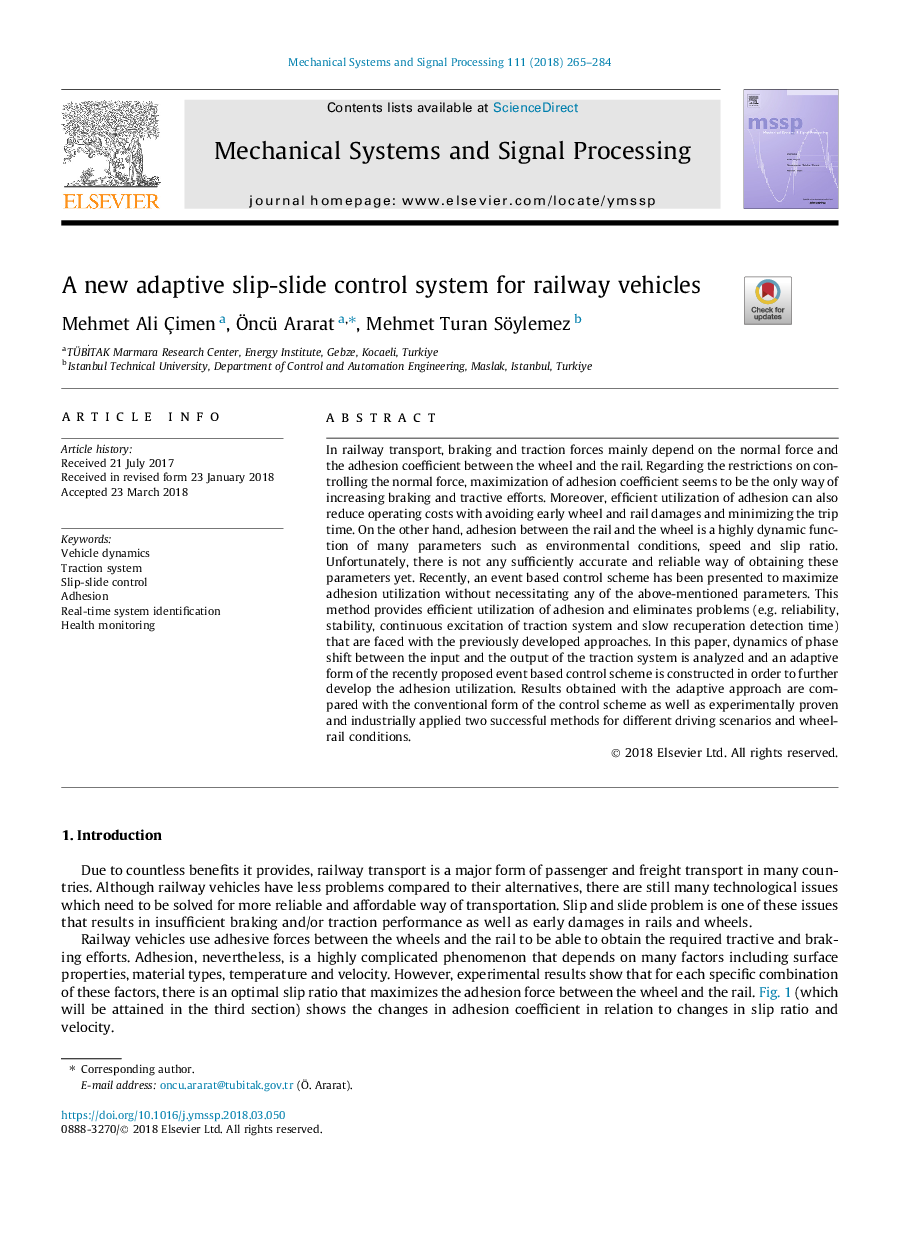| کد مقاله | کد نشریه | سال انتشار | مقاله انگلیسی | نسخه تمام متن |
|---|---|---|---|---|
| 6953866 | 1451824 | 2018 | 20 صفحه PDF | دانلود رایگان |
عنوان انگلیسی مقاله ISI
A new adaptive slip-slide control system for railway vehicles
ترجمه فارسی عنوان
یک سیستم کنترل لغزش لغزنده جدید برای وسایل نقلیه راه آهن
دانلود مقاله + سفارش ترجمه
دانلود مقاله ISI انگلیسی
رایگان برای ایرانیان
کلمات کلیدی
دینامیک خودرو، سیستم کشش، کنترل کشویی لغزش، چسبندگی، شناسایی سیستم در زمان واقعی، نظارت بر سلامت،
ترجمه چکیده
در حمل و نقل راه آهن، نیروهای ترمز و کشش عمدتا به نیروی عادی و ضریب چسبندگی بین چرخ و ریل بستگی دارد. با توجه به محدودیت های کنترل نیروی عادی، به نظر می رسد حداکثر سازی ضریب چسبندگی تنها راه افزایش تدابیر ترمز و کشش است. علاوه بر این، استفاده موثر از چسبندگی همچنین می تواند هزینه های عملیاتی را کاهش دهد و از آسیب های ناشی از چرخش و ریل جلوگیری کند و زمان سفر را کاهش دهد. از سوی دیگر، چسبندگی بین ریل و چرخ یک عملکرد بسیار پویا از بسیاری از پارامترهای مانند شرایط محیطی، سرعت و لغزش است. متأسفانه هیچ راهی به اندازه کافی دقیق و قابل اعتماد برای به دست آوردن این پارامترها وجود ندارد. اخیرا یک طرح کنترل مبتنی بر رویداد برای به حداکثر رساندن استفاده از چسبندگی بدون نیاز به هر یک از پارامترهای فوق ارائه شده است. این روش باعث استفاده موثر از چسبندگی و از بین بردن مشکلات (مثلا قابلیت اطمینان، ثبات، تحریک مداوم سیستم کشش و زمان تشخیص بازخورد) است که با رویکردهای قبلا توسعه یافته روبرو هستند. در این مقاله دینامیک تغییر فاز بین ورودی و خروجی سیستم کشش مورد تجزیه و تحلیل قرار گرفته است و یک فرم سازگار از طرح کنترل مبتنی بر رویداد اخیرا پیشنهاد شده است تا به منظور توسعه استفاده از چسبندگی. نتایج به دست آمده با رویکرد انطباق با شکل متعارف طرح کنترل و همچنین تجربی اثبات شده و کاربردی صنعتی دو روش موفق برای سناریوهای مختلف رانندگی و شرایط ریل چرخان مقایسه شده است.
موضوعات مرتبط
مهندسی و علوم پایه
مهندسی کامپیوتر
پردازش سیگنال
چکیده انگلیسی
In railway transport, braking and traction forces mainly depend on the normal force and the adhesion coefficient between the wheel and the rail. Regarding the restrictions on controlling the normal force, maximization of adhesion coefficient seems to be the only way of increasing braking and tractive efforts. Moreover, efficient utilization of adhesion can also reduce operating costs with avoiding early wheel and rail damages and minimizing the trip time. On the other hand, adhesion between the rail and the wheel is a highly dynamic function of many parameters such as environmental conditions, speed and slip ratio. Unfortunately, there is not any sufficiently accurate and reliable way of obtaining these parameters yet. Recently, an event based control scheme has been presented to maximize adhesion utilization without necessitating any of the above-mentioned parameters. This method provides efficient utilization of adhesion and eliminates problems (e.g. reliability, stability, continuous excitation of traction system and slow recuperation detection time) that are faced with the previously developed approaches. In this paper, dynamics of phase shift between the input and the output of the traction system is analyzed and an adaptive form of the recently proposed event based control scheme is constructed in order to further develop the adhesion utilization. Results obtained with the adaptive approach are compared with the conventional form of the control scheme as well as experimentally proven and industrially applied two successful methods for different driving scenarios and wheel-rail conditions.
ناشر
Database: Elsevier - ScienceDirect (ساینس دایرکت)
Journal: Mechanical Systems and Signal Processing - Volume 111, October 2018, Pages 265-284
Journal: Mechanical Systems and Signal Processing - Volume 111, October 2018, Pages 265-284
نویسندگان
Mehmet Ali Ãimen, Ãncü Ararat, Mehmet Turan Söylemez,
